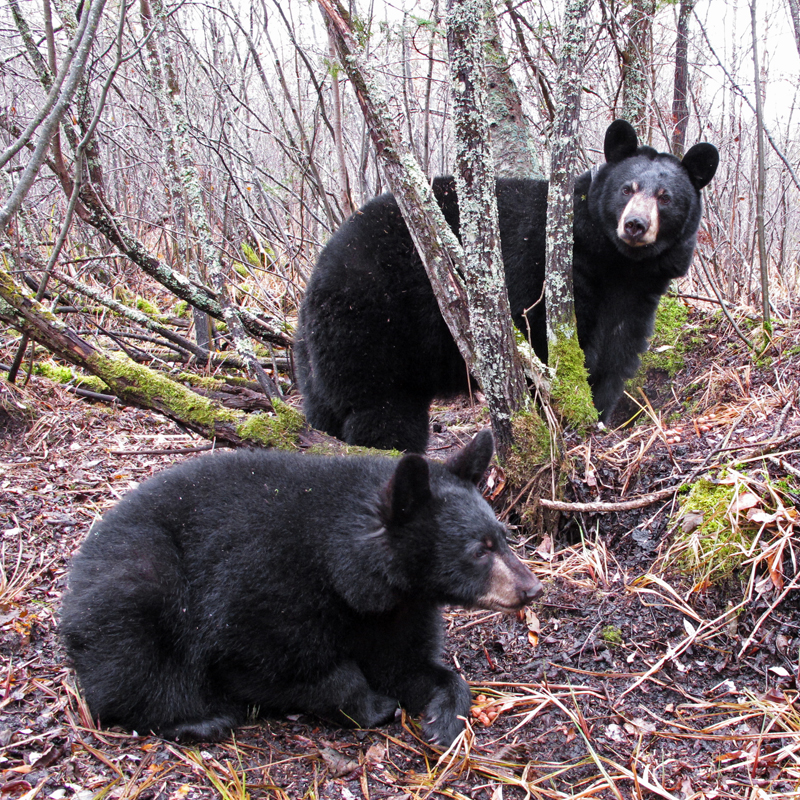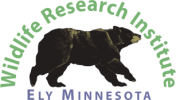Wounding loss and human safety
Wounding loss and human safety
Update October 28, 2010 – 7:44 PM CDT
 We’re waiting out the weather to do some final den checks. After we check and find the research bears in dens, we check again later from a distance to see if any of them surprised us by moving. We do that again after deer hunting season in late November because some bears move yet again with so many people in the woods. We also plan to check some old rock dens that we’ve been checking for decades for re-use.
We’re waiting out the weather to do some final den checks. After we check and find the research bears in dens, we check again later from a distance to see if any of them surprised us by moving. We do that again after deer hunting season in late November because some bears move yet again with so many people in the woods. We also plan to check some old rock dens that we’ve been checking for decades for re-use.
A hunter from Pennsylvania kindly let us know we might have offended hunters with the update last night with our reference to “quick shots at poorly identified targets that risk wounding bears and shooting people.” The hunter said that he didn’t do that. And truly, most don’t.
Here’s what we were trying to say.
Wounding loss is one of the biggest problems in bear hunting. An Ontario study placed it at 13%. Across the continent, with a kill of about 55,000, a wounding loss of 13% would mean 5,000 to 6,000 bears slowly dying or slowly healing after bear season. The key to reducing wounding is waiting for a killing shot. That means passing up shots where the target is poorly identified in dense vegetation or low light. Yet, the top excuse we hear for not making it illegal to shoot radio-collared bears is that it may be difficult for hunters to see collars and ribbons in dense vegetation and low light. To us, that sounds like officials are condoning shooting under those conditions—conditions in which most hunters would not shoot for fear of wounding a bear or mistaking a person for a bear. This is an important issue. We don’t want hunters shooting under those conditions when we are right behind a bear we are following.
The problem of human safety is bigger than that. The highest bear kill is during the busy Labor Day Weekend when leaves are still on the bushes and many holiday hikers have no idea it is bear hunting season. They aren’t wearing orange, and orange might not help them anyway because leaves are still on the bushes. The hikers are unseen through leaves that obscure vision but don’t stop bullets. We think officials should do everything possible to encourage hunters to fully identify their targets, look twice for collars and ribbons, and wait for killing shots. One thing that could be done is make it illegal to shoot radio-collared bears—not protect hunters who might take such shots by saying that under some conditions it is hard to see radio-collars and ribbons.
We have written before about the reasons for bear hunting and why we support a hunting season in Minnesota, but we also believe that these radio-collared bears should be protected for their values to science, bear management, education, and the regional economy. They are also valuable to hunters. Protecting these bears means we can educate more people about the nature of bears. The more people know, the more willing they become to coexist with bears, which can lead to higher bear populations. In Minnesota, a combination of regulated hunting and education has quadrupled the population, which means more bears for people to see and to hunt.
Prior to 1971, the year bears were elevated to big game status, they were officially varmints that could be killed in any number, manner, and season. One of Lynn’s proudest achievements is working with Richard Anderson and legislators to end this varmint status and elevate bears to big game status with regulated killing. Lynn was asked by the MN DNR to write the initial bear hunting regulations, and he wrote the regulations to be as humane as possible with minimum wounding loss. Every bear that is wounded and goes off to die or suffer means another bear must die to fill the hunter’s tag. There is no place in bear hunting for reckless shooting. Most hunters are responsible enough not to do it. Responsible hunters must roll their eyes when hearing the excuse that it has to be legal to shoot radio-collared bears because a hunter could make an honest mistake while shooting in low light or under conditions of low visibility.
What a big surprise at the Bear Center today! You sent 8 pizzas, super salad, cookies, and the first cannoli any of us have ever tasted. Thank you!
In fact, thank you for all you do.
—Lynn Rogers and Sue Mansfield, Biologists, Wildlife Research Institute and North American Bear Center
